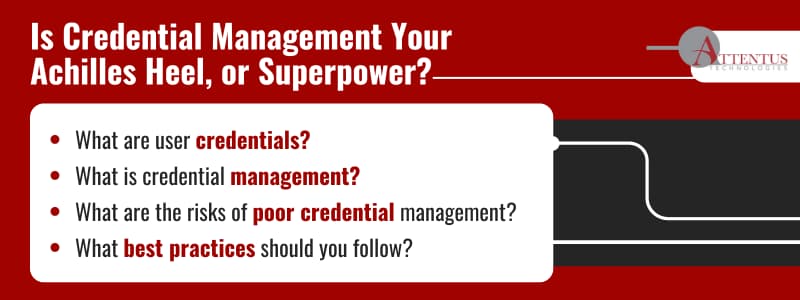Can you prove who has access to the five most critical accounts in your business? Your organization’s greatest strength could also be its biggest vulnerability: your credentials. One stolen login can let an attacker bypass every security tool you’ve invested in—no malware required.

Could user credentials be your business’s #1 security weak spot?
Verizon’s 2025 Data Breach Investigations Report (DBIR) suggests it’s highly likely: 88% of web app attacks leverage stolen credentials. SMBs are disproportionately affected because attackers assume smaller teams aren’t managing credential sprawl.
That means nearly 9 out of 10 web application breaches start with compromised logins…not with fancy malware. Why? Because it’s the path of least resistance, and often, all attackers need.
Have you invested in credential management? Many don’t until it’s too late. Fortunately, that doesn’t have to be you.
With a robust credential management system (CMS) implemented with the help of your I.T. partner, you can better control access, protect sensitive data, and reduce breach risk.
Here’s a quick guide to get you up to speed.
What Are User Credentials (and Why They Matter)
Let’s start from the beginning. What are user credentials?
In simple terms, they’re digital identifiers that grant people access to your systems. They’re the “digital keys to your kingdom”…and hackers know it. Think of credentials as ID badges: if one falls into the wrong hands, it’s a free pass into your business.
The most common types are:
- Usernames and passwords
- Cryptographic keys
- Biometrics
Without user credentials, there’s no way to safeguard confidential customer or company data, or keep track of who’s accessing what.
That said, user credentials aren’t a “set and forget” feature. Logins need to be tracked, passwords need to be kept secure, and suspicious activity should be anticipated.
Poor credential management exposes your organization to serious risks, like phishing, dark web credential leaks, shared accounts, orphaned logins, and password reuse. Any of these could lead to a data breach, fines, downtime, and reputational harm for your organization.
For example, an old employee’s login leaked on the dark web can give attackers permanent access.
What’s my action item? Audit whether all current and former employees have the appropriate level of access or still retain access at all.
So What Is Credential Management, Then?
Credential management is how your business controls and protects access to its digital resources…ensuring only the right people have the right keys at the right time. In short, credential management ensures the wrong person can’t access the right system.
A modern credential management system (CMS) makes it easier for your organization to issue and store credentials correctly and safely, and tie them to specific identities and roles in your organization, so that only authorized people have the keys to your I.T. estate at any point in time.
Key features of a reliable CMS include:
- Automated provisioning/deprovisioning: Reduces human error and speeds up onboarding/offboarding.
- Centralized key vaults: Eliminate insecure storage like spreadsheets or shared folders.
- Data encryption: Protects sensitive information from unauthorized access and reduces the risk of data breaches.
- Seamless integration with HR systems, directory services, and other IT tools: Removes manual updates, keeps user data in sync, and strengthens overall security consistency.
Let’s take a closer look at how all these work together.
What’s my action item? If you’re still manually assigning accounts, you need to evaluate CMS solutions immediately.
Credential Management Systems in Action
Modern cloud-based CMSs automate provisioning, revocation, and several other aspects of your credential management strategy.
So, for example, when HR adds a new hire, you can instantly create a new account based on their role, taking stress out of the onboarding process. In short, automating credential management reduces human error, which is still the leading cause of breaches.
Similarly, you can take the swift and decisive action of rendering credentials ineffective when they’re no longer needed (such as when an employee leaves) or when there’s evidence of a security compromise.
Secret managers and key vaults ensure that database credentials are stored safely while also automating their periodic rotation.
On the other hand, APIs allow applications and servers to retrieve your passwords, SSH keys, and certificates on demand without hardcoding them. This both centralizes management of those secrets and replaces ad-hoc scripts or shared files.
All this culminates in a more resilient environment with a strong audit trail, zero orphan accounts, and that’s less susceptible to both external and insider threats
What’s my action item? Require your CMS to provide automated reporting of active vs. inactive accounts monthly.
Identity, Credential, and Access Management (ICAM)
Credential management is one piece of the broader ICAM framework. Think of ICAM as the system that determines who someone is, how they prove it, and what they’re allowed to access. It’s what helps you enforce least-privilege access and avoid over-permissioning.
Key things to implement for stronger ICAM include:
A Hardware Security Module (HSM) should be implemented alongside your credential management software for more resilience.
What’s my action item? Enforce MFA for all remote or sensitive access points.
What Is a Hardware Security Module (HSM)?
An HSM keeps your encryption keys locked inside specialized hardware so attackers can’t steal or copy them. It works with your CMS software to strengthen overall credential lifecycle management.
Here, CMS operations, such as key generation, storage, and usage, are anchored in the HSM, ensuring nobody (not even a hacker with server access) can extract them.
What’s my action item? If your business handles regulated data (such as healthcare, finance, or legal), you require HSM support from your provider.
Credential Management Best Practices
Take these steps to maximize the value of your CMS.
- Automate account provisioning and deprovisioning.
- Use unique, complex, and rotating passwords.
- Implement role-based access and least privilege.
- Regularly audit accounts and access logs.
- Encrypt credentials at rest and in transit.
- Enforce MFA for that extra layer of security.
If you’re unsure how to get started, a managed services provider (MSP) can simplify the process.
What’s my action item? Schedule credential audits at least quarterly, and immediately after staff turnover.
Partnering with an MSP for Credential Management
Tapping an MSP to provide expert selection, integration, and ongoing monitoring of your credential and access management solution is a great way to avoid some of the pitfalls SMBs face.
Managing credentials effectively can be complex, especially for small and mid-sized businesses. Partnering with a managed service provider (MSP) gives you access to expert guidance, compliance support, and continuous monitoring.
An MSP like Attentus provides dark web monitoring, credential reporting, compliance guidance, and continuous audit support…capabilities most SMBs don’t have internally.
What’s my action item? When evaluating MSPs, ask: Do you provide credential reporting and dark web monitoring as part of your managed services?
Credentials Are Your First (and Weakest) Line of Defense. Invest in a Robust Strategy.
Make no mistake: A robust credential and access management strategy is what will protect you if credentials are stolen, not firewalls and antivirus software (although these have their place in a well-balanced cybersecurity strategy).
Delaying the implementation of your CMS and ICAM strategies is to forego critical organizational safety. That’s where Attentus comes in.
At Attentus Technologies, one of our core values is to “be the answer” to the problems our clients face. Right now, one prevailing issue in the cybersecurity landscape is the use of stolen credentials to compromise organizations in 88% of web application attacks. Should one stolen password be enough to take your business down?
We say NO, and can help you build an enterprise-grade credential and access management solution to keep the bad guys out, completely.
Let’s start with a custom credential management assessment to gauge your exposure and determine how to ramp up your security.
